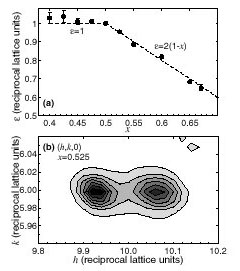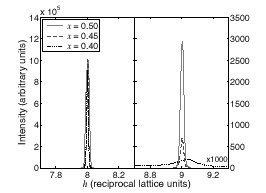
Simon Larochelle and co-workers have grown single crystals at Stanford's new Laboratory for Advanced Materials and carried out x-ray scattering studies at SSRL Beamline 7-2 to establish the low-temperature structural phase diagram of Mn214 [1]. For x = 1/2, this study provides a more complete picture than previous neutron [2] and x-ray [3] scattering experiments. An investigation of the effects of varying the eg electron concentration (ne = 1 - x) in the MnO2 layers revealed three distinct regions: disordered (x < 0.4), mixed-phase (0.4 < x < 0.5), and charge-ordered (x >0.5). Above x = 0.5, the ordering of eg electrons is found to result in a structural distortion whose modulation period only depends on ne. Even though Mn214 does not exhibit CMR, this trend resembles findings for La1-xCaxMnO3, which is a CMR material. This behavior furthermore is reminiscent of the charge- and spin-density wave order tendencies in the hole-doped layered cuprates and nickelates. The results of this study thus provide valuable quantitative information for tests of theories for CMR materials and layered transition metal oxides.

(a) Superlattice wave vector (±e, 0, 0)o as a function of x for La1-xSr1+xMnO4. The dashed line for x > 0.5 is e = 2(1 - x) = 2ne. (b) Linear-scale contour map (10% contours) of the scattering intensity around (10, 6, 0)o for x = 0.525.

H scans through the (8, 4, 0)o and (9, 4, 0)o reflections for x = 0.40, 0.45, and 0.50 (T = 100 K). The (8, 4, 0)o peak intensities are normalized to 106. Below x=0.50, the (9, 4, 0)o superlattice peak intensity decreases considerably with decreasing x. For x = 0.40, the peak is noticeably broadened and its intensity is ~104 weaker than for x = 0.50 reflecting mixed-phase behavior
- S. Larochelle et al., Phys. Rev. Lett. 87, 095502 (2001).
- B. J. Sternlieb et al., Phys. Rev. Lett. 76, 2169 (1996).
- Y. Murakami et al., Phys. Rev. Lett. 80, 1932 (1998).
SSRL Highlights Archive
![]()
